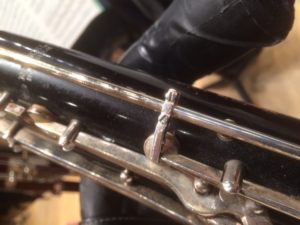Test 16
Test 17
Test 18
Test 19
Introduction
You may wonder why high G is not included in the middle register tuning even though it follows the same harmonic tuning technique. It is a new register with a different resistance and mode of vibration from its neighbor F# of the middle register. The proper tuning and response of G and its neighbor, Ab, are the springboards to the high register. It is common for the upper register notes to be pinched and sharp in pitch. The properly tuned reed will allow the upper register notes to be played with ease with the final test number 20’s question (Can you play the entire range of the bassoon with the reed in the corner of your mouth? Yes we can!)
Test 16: The “G” Gateway Note
High G opens the door to the upper register but is also critical in slurring back to the middle register and especially those notes that tend to hang on a down slur. If the G harmonic is flat, there is a tendency for the upper register notes to be pinched and small in tone to achieve response especially in rapid articulation leading to sharpness in pitch.
Strive to get a balance between the tuning of harmonic G and Ab. Check this tuning often as the reed will change as it ages causing the G harmonic and the Ab harmonic to go sharp. The tiniest adjustment may be all that is needed to restore the balanced tuning. In the case of the flat G, a little sand paper on the rails may be all that is needed.
This is an additional fine tuning test for G3. We find it to be very important for tuning and upper register response. It is my secret fingering for the tricky passage in The Rite of Spring for the quick back-and-forth triplet, B to G. (For my students, my secret fingerings were referred to by dollar amounts. This one is worth $500. Of course, they never pay me!)
Test: B to G Slur Down
 Slur back and forth from the standard B4 fingering to the Alternate G3 fingering to check ease of response.
Slur back and forth from the standard B4 fingering to the Alternate G3 fingering to check ease of response.
Observations:
- G doesn’t speak, hesitates, or “hangs”.
- G produces a multi-phonic or a lower note.
- G produces a multi-phonic or moves up to A3 or higher note.
Use the solutions for “If Sharp or Unstable on Harmonic” from the Quick Guide.
Test: Slur Up to G
Can you play the passage from Scheherazade without having to push or accent the G to get it to speak? Can you slur up from D to G with a diminuendo and without the use of the whisper key, keeping the first finger (L.H.) open (no half hole)?
Observations:
- G doesn’t speak or hesitates
- G is sharp
- G must be accented
Test 17
For those who suffer with problems on high A and Bb, there are several solutions:
- Reduce the size of the C# tone hole with tape.
- Reduce the pad height for the C# tone hole.
- Revise the tone hole to a longer/larger, metal-lined tone hole.
- Add a bridge key from the A/Bb register key to the whisper key. These can be added to Fox instruments by the factory.

Test 18
Pezzi Twist
This embouchure shift effectively shortens the vibrating length of the blade and at the same time keeps the tip open through a controlled “bite.” The final effect is essentially a shorter, narrower reed. This is accomplished by changing the angle of your head: rotate the center of your embouchure to the right with the upper lip at the back of the blade next to the collar and the lower lip to the left edge of the bottom blade. (photo)
Test 19: Upper Register Articulations
Quick response to articulation in the high register is a less common requirement than in other registers. However, it should be tested and responsive. For instance, Hell’s Angels by Michael Daugherty for bassoon quartet and orchestra (recorded by the Bassoon Brothers) requires double tonguing up to high C. Daughtery’s Bounce for two bassoons also requires double tonguing in the high range.
Here is an example from Debussy Nocturnes that can be challenging:
Extreme High Register Solutions
Hole in the Reed or Bocal
This is a magic bullet! Drill a hole in the top of the reed (Fig. 19D) or bocal. Start with the smaller diameter and increase in size until you get the response you want. Be sure to drill in the side of the reed you’ll be playing up so that it does not become clogged with moisture as you are playing. The author prefers making a hole in the reed rather than the bocal. The downside is a stream of air blowing up into your nose! For those who prefer to make a hole in the bocal, keep it covered with tape until needed. Bocals that are typically not responsive in the extreme upper register are suddenly able to pick off or respond to the highest notes with an added hole in the reed or bocal.
Coming soon: Harris-Wangler High Note Fingering Chart


